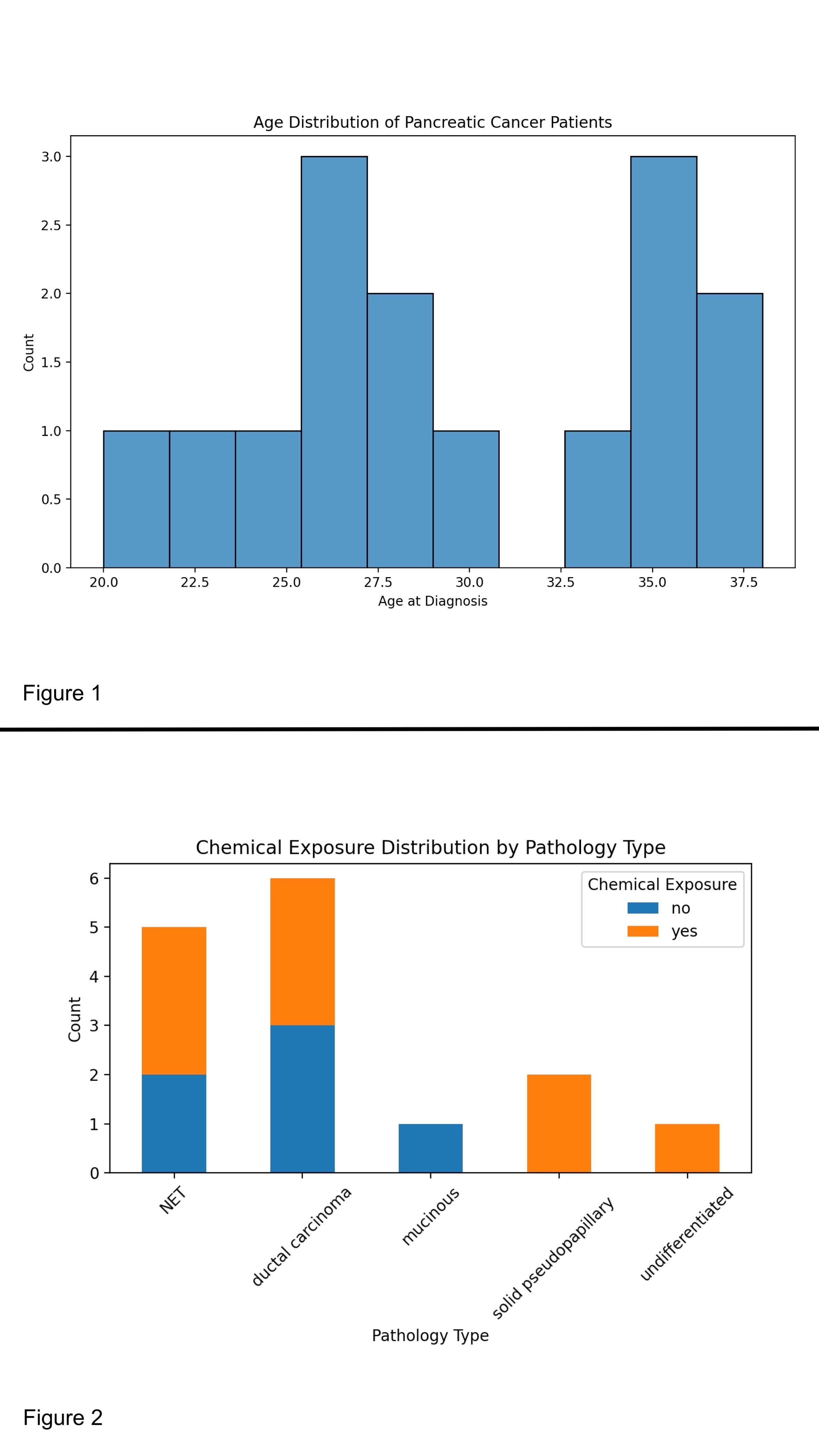Sunday Poster Session
Category: Biliary/Pancreas
P0017 - Shifting Demographics: Investigating Pancreatic Cancer in Younger Populations
Sunday, October 26, 2025
3:30 PM - 7:00 PM PDT
Location: Exhibit Hall
- RM
Raakhi Menon, DO
University of Texas Medical Branch
Galveston, TX
Presenting Author(s)
Raakhi Menon, DO, Anirudha Chatterjee, MD, Muhammad Mushtaq, DO, Juliana Yang, MD
University of Texas Medical Branch, Galveston, TX
Introduction: Early-onset pancreatic cancer is on the rise, especially among younger women, notably Black and Hispanic individuals. Current screening targets high-risk patients with genetic or familial predispositions, with American Gastroenterological Association and American Society for Gastrointestinal Endoscopy recommending individualized approaches at specialized centers. The U.S. Preventive Services Task Force advises against routine screening in average-risk populations due to low yield and potential harms.
Methods: This retrospective study evaluated all patients at a tertiary care center who underwent biopsy of a pancreatic mass between 09/2015 to 09/2024. Inclusion criteria included patients aged 18 to 39 at the time of pancreatic cancer diagnosis, with pathology confirming malignancy. Patients were excluded if imaging or biopsy was performed as part of screening due to a known genetic predisposition. Data were collected on demographics, medical, family, and social histories, as well as residential addresses and proximity to facilities listed by the United States Environmental Protection Agency (EPA) as part of the Toxics Release Inventory (TRI).
Results: Of 451 patients, 15 met inclusion criteria. The median age was 28 (IQR: 26.5–35.5), with 53.5% female and 60% identifying as Hispanic or Black. Pathology showed adenocarcinoma in 40% and neuroendocrine tumors (NET) in 33.3%. Median BMI was 26 (IQR: 23.4–34.4); 53.3% had a smoking history, and 73.3% consumed alcohol. Sixty percent lived near EPA-designated chemical release sites, with an all-cause mortality rate of 13.3%. Among the 9 patients in higher-exposure areas, 33.3% had adenocarcinoma, 33.3% NET, 11.1% undifferentiated carcinoma, and 22.2% solid pseudopapillary neoplasms. This subgroup was 66.7% Hispanic or Black, 55.6% female, and had a 22.2% mortality rate.
Discussion: The results highlight a rising incidence of pancreatic cancer in young adults, particularly among Hispanic, Black, and female patients. Most lived near areas of significant chemical exposure, which was linked to more aggressive cancer types and higher mortality. These findings suggest environmental carcinogens may be a relevant screening risk factor, warranting further study in larger populations.

Figure: Table 1: Breakdown of Patient Demographics and Clinical Characteristics

Figure: Figure 1: Age Distribution of Patients at Pancreatic Cancer Diagnosis
Figure 2: Pancreatic Cancer Subtypes in Relation to Environmental Exposures
Disclosures:
Raakhi Menon indicated no relevant financial relationships.
Anirudha Chatterjee indicated no relevant financial relationships.
Muhammad Mushtaq indicated no relevant financial relationships.
Juliana Yang indicated no relevant financial relationships.
Raakhi Menon, DO, Anirudha Chatterjee, MD, Muhammad Mushtaq, DO, Juliana Yang, MD. P0017 - Shifting Demographics: Investigating Pancreatic Cancer in Younger Populations, ACG 2025 Annual Scientific Meeting Abstracts. Phoenix, AZ: American College of Gastroenterology.
University of Texas Medical Branch, Galveston, TX
Introduction: Early-onset pancreatic cancer is on the rise, especially among younger women, notably Black and Hispanic individuals. Current screening targets high-risk patients with genetic or familial predispositions, with American Gastroenterological Association and American Society for Gastrointestinal Endoscopy recommending individualized approaches at specialized centers. The U.S. Preventive Services Task Force advises against routine screening in average-risk populations due to low yield and potential harms.
Methods: This retrospective study evaluated all patients at a tertiary care center who underwent biopsy of a pancreatic mass between 09/2015 to 09/2024. Inclusion criteria included patients aged 18 to 39 at the time of pancreatic cancer diagnosis, with pathology confirming malignancy. Patients were excluded if imaging or biopsy was performed as part of screening due to a known genetic predisposition. Data were collected on demographics, medical, family, and social histories, as well as residential addresses and proximity to facilities listed by the United States Environmental Protection Agency (EPA) as part of the Toxics Release Inventory (TRI).
Results: Of 451 patients, 15 met inclusion criteria. The median age was 28 (IQR: 26.5–35.5), with 53.5% female and 60% identifying as Hispanic or Black. Pathology showed adenocarcinoma in 40% and neuroendocrine tumors (NET) in 33.3%. Median BMI was 26 (IQR: 23.4–34.4); 53.3% had a smoking history, and 73.3% consumed alcohol. Sixty percent lived near EPA-designated chemical release sites, with an all-cause mortality rate of 13.3%. Among the 9 patients in higher-exposure areas, 33.3% had adenocarcinoma, 33.3% NET, 11.1% undifferentiated carcinoma, and 22.2% solid pseudopapillary neoplasms. This subgroup was 66.7% Hispanic or Black, 55.6% female, and had a 22.2% mortality rate.
Discussion: The results highlight a rising incidence of pancreatic cancer in young adults, particularly among Hispanic, Black, and female patients. Most lived near areas of significant chemical exposure, which was linked to more aggressive cancer types and higher mortality. These findings suggest environmental carcinogens may be a relevant screening risk factor, warranting further study in larger populations.

Figure: Table 1: Breakdown of Patient Demographics and Clinical Characteristics

Figure: Figure 1: Age Distribution of Patients at Pancreatic Cancer Diagnosis
Figure 2: Pancreatic Cancer Subtypes in Relation to Environmental Exposures
Disclosures:
Raakhi Menon indicated no relevant financial relationships.
Anirudha Chatterjee indicated no relevant financial relationships.
Muhammad Mushtaq indicated no relevant financial relationships.
Juliana Yang indicated no relevant financial relationships.
Raakhi Menon, DO, Anirudha Chatterjee, MD, Muhammad Mushtaq, DO, Juliana Yang, MD. P0017 - Shifting Demographics: Investigating Pancreatic Cancer in Younger Populations, ACG 2025 Annual Scientific Meeting Abstracts. Phoenix, AZ: American College of Gastroenterology.
